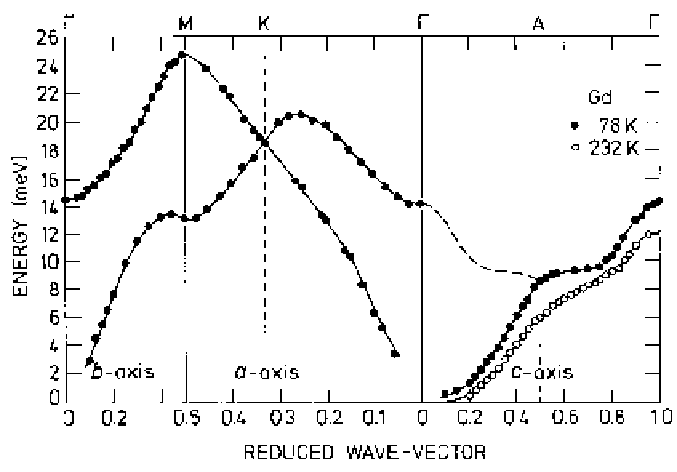Environmental Engineering Reference
In-Depth Information
Fig. 5.1.
Spin-wave dispersion relations for Gd, after Koehler
et
al.
(1970). The two atoms of the hcp structure give rise to acoustic
and optical branches. Since the single-ion anisotropy is negligible, the
acoustic mode rises quadratically from the origin.
Because
L
=0,sothat
J
=
S
, anisotropy effects are small in Gd,
and it is therefore a good approximation to a Heisenberg ferromagnet.
Using the above procedure to generalize (3.5.26) to the hcp structure,
we obtain the two branches of the excitation spectrum
J
z
J
1
(
0
)+
|
E
Ac
q
=
J
2
(
0
)
−J
1
(
q
)
−|J
2
(
q
)
J
z
J
1
(
0
)+
|
,
(5
.
1
.
9)
E
Op
q
=
J
2
(
0
)
−J
1
(
q
)+
|J
2
(
q
)
since
J
2
(
0
) is positive. The dispersion relations measured by inelastic
neutron scattering by Koehler
et al.
(1970) are shown in Fig. 5.1. This
figure illustrates the use of the double-zone representation when
q
is
along the
c
-axis, resulting in a single spin-wave branch. The renormal-
ization predicted by the simple RPA theory, that
E
q
(
T
) is proportional
to
σ
, is not followed very precisely.
σ
changes from about 0.97 at 78 K
to 0.66 at 232 K. As may be seen from Fig. 5.1, and from more exten-
sive studies by Cable
et al.
(1985), the energies in the
c
-direction vary
approximately like
σ
0
.
5
at the largest wave-vectors, like
σ
in the mid-
dle of the branch, and faster than
σ
at small wave-vectors. However, it
is also evident from the figure that the form of
(
q
) changes with de-
creasing magnetization, so some of the discrepancy between the simple
J

Search WWH ::

Custom Search